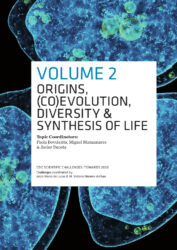Coordinación: Paola Bovolenta; Miguel Manzanares; Javier Buceta
Fecha de publicación: 10 de marzo de 2021
Idioma: Inglés
Temática: Ciencias de la Vida
Colección: CSIC Scientific Challenges: Towards 2030
Número de páginas: 185
Otros datos: CSIC Scientific Challenges: Towards 2030, Vol. 2
Jornada de presentación disponible en CSIC Comunicación
Este es el volumen 2 de los 14 «Libros Blancos del CSIC» que definen su estrategia hasta 2030.
El libro contiene 8 retos. El reto «The origins of life: from chemistry to biology» (páginas 20 a 53 de ese PDF) ha sido coordinado por Carlos Briones Llorente (CAB) y co-coordinado por Izaskun Jimenez-Serra (CAB)
Otros investigadores del CAB que han participado en este reto son: Jacobo Aguirre, David Hochberg, Eva Mateo Martí y Marta Ruiz Bermejo.
How life appeared on Earth and how then it diversified into the different and currently existing forms of life are the unanswered questions that will be discussed this volume. These questions delve into the deep past of our planet, where biology intermingles with geology and chemistry, to explore the origin of life and understand its evolution, since “nothing makes sense in biology except in the light of evolution” (Dobzhansky, 1964). The eight challenges that compose this volume summarize our current knowledge and future research directions touching different aspects of the study of evolution, which can be considered a fundamental discipline of Life Science. The volume discusses recent theories on how the first molecules arouse, became organized and acquired their structure, enabling the first forms of life. It also attempts to explain how this life has changed over time, giving rise, from very similar molecular bases, to an immense biological diversity, and to understand what is the hylogenetic relationship among all the different life forms. The volume further analyzes human evolution, its relationship with the environment and its implications on human health and society. Closing the circle, the volume discusses the possibility of designing new biological machines, thus creating a cell prototype from its components and whether this knowledge can be applied to improve our ecosystem. With an effective coordination among its three main areas of knowledge, the CSIC can become an international benchmark for research in this field.







